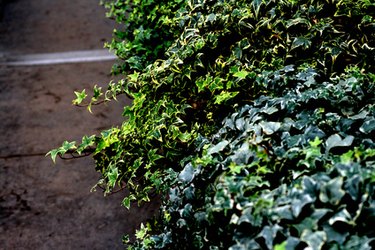
The lush and rapid growth of English ivy (Hedera helix) makes it a popular choice for dappled to fully shaded landscapes in U.S. Department of Agriculture plant hardiness zones 4 through 9. Ivy light requirements also allow it to thrive indoors in windows covered by sheer or lightweight curtains as well as in lower-light locations. It tolerates cold weather, so it doesn't have to be taken indoors in winter.
English Ivy Light Requirements
Video of the Day
English ivy prefers shade, from dappled to deep shade. While it may tolerate some morning sun, too much direct sunlight scorches the leaves and affects the plant's growth. Shade that is too deep also affects the ivy's growth, resulting in leggy stems and foliage as the plant reaches toward the light. In general, English ivy light requirements start with at least 200 foot candles and for best growth, 500 to 1,000 foot candles for eight to 10 hours daily.
Video of the Day
Indoors, keep your English ivy in a brightly lit location where it receives plenty of filtered or indirect sunlight. While a north-facing window doesn't require curtains, east-facing, west-facing and south-facing windows should be covered with sheer or lightweight curtains that block the sun's rays while letting light into the room.
Ivy placed in a dark corner may need supplemental light, such as a grow light or fluorescent fixture. Place the light a few inches above the top leaves of the plant. Mirrors placed behind or to the side of the plant help reflect light onto the leaves. While not as effective as direct light sources, it helps keep the plant growing evenly without requiring weekly repositioning.
Issues With English Ivy
English ivy sap can cause skin irritation in sensitive individuals. Always wear safety goggles and gloves to protect your eyes and skin from the sap. Keep the plant out of reach of children and pets.
In addition to the mildly toxic sap, English ivy is considered invasive in the Eastern states and the Pacific Northwest. The rampant vines crowd out native species and climb up and over trees, fences and the sides of buildings. Because the vines root wherever they touch the soil, once established in the landscape, this shade-loving vine is difficult to eradicate.
English ivy also provides a moist habitat for snails and slugs. Rats and other rodents hide amid the vines as they feed on desirable plants, shrubs, trees and the fruits from your home orchard.
Other Low-Light Vine Plants
English ivy includes hundreds of cultivars. The leaves range from small to large, smooth and curly and in various shades of green or variegated with white, cream or yellow and green. While most younger ivies are vines, mature English ivy may develop into a shrub or treelike form. Once it transforms into its mature, upright form, cuttings will not revert to vines; they will also grow into free-standing plants.
Other types of ivy plants include Boston ivy (Parthenocissus tricuspidate), Irish ivy (Hedera hibernica), Japanese ivy (Hedera rhombea) and Swedish ivy (Plectranthus australis). Irish and Japanese ivies share similar light requirements as English ivy. Hardy in USDA zones 5 through 11 and 8 through 9 respectively, Irish and Japanese ivy may produce clusters of yellow and yellow-green flowers and black to blue-black berries. Irish ivy tolerates more sun than English and Japanese ivies.
Though Boston ivy and Swedish ivy, hardy in USDA zones 4 through 8 and 10 through 11, are not members of the ivy family, they share similar characteristics and leaf shapes as the real ivies. Boston ivy is deciduous; the leaves change from green to red and purple before dropping from the vine in winter. Boston ivy thrives in full sun, while Swedish ivy prefers dappled or partial shade. Of all the ivy and ivylike species, Swedish ivy is the best indoor plant if your space is limited because its vines are only 3 feet long.